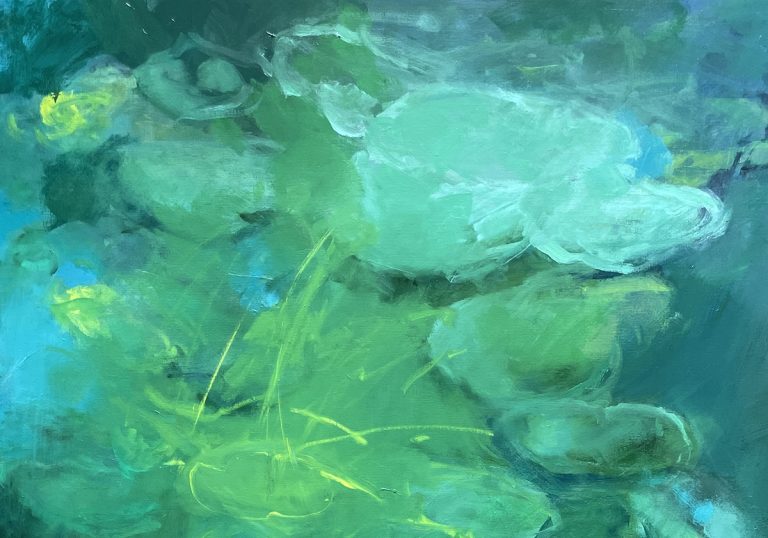Eva Lemay’s painting practice begins not with observation, but with sensation. She works from what she feels more than what she sees—letting color, gesture, and rhythm guide her into each piece. Her relationship to the landscape isn’t just visual; it’s physical, emotional, and almost ritualistic. Raised with a deep attachment to the natural world, Lemay paints to keep that connection alive. Each canvas becomes a fragment of time and place, not documented but remembered in movement, breath, and light. She works in oils, letting the material remain fluid—blending greens, blues, yellows in ways that mirror the organic world itself. Her brush doesn’t aim to fix or replicate, but to evoke—slowness, fragility, presence. For Lemay, painting is a form of listening. A way to stay in touch with what still surrounds us, even as it shifts or disappears.
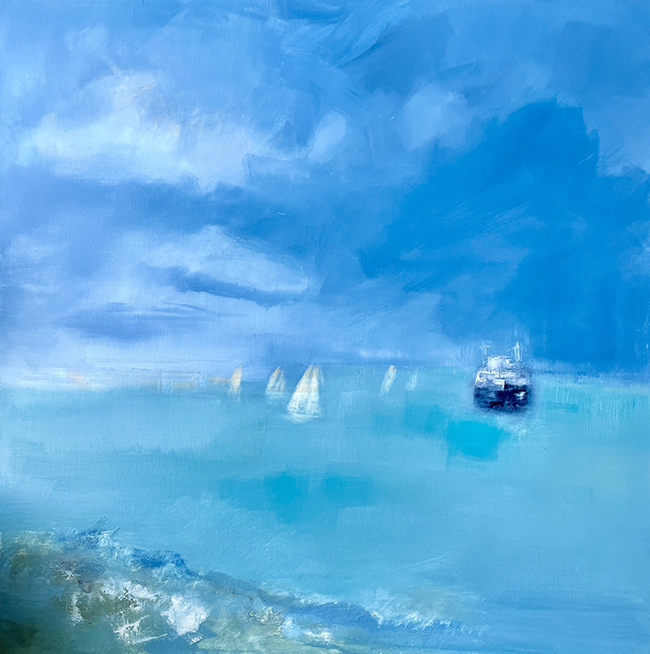
Lemay’s landscapes move. They shimmer, breathe, drift—and yet they feel suspended in time. In her seascape, the edge between water and sky almost disappears. There’s a haze where the sea meets the air, a softened horizon where small sailboats drift, ghostlike, beneath a heavy cloud bank. Off to the right, a single dark ship holds its position, anchoring the scene just as it begins to dissolve. The palette—turquoise, white, and cool blue—stays quiet, giving the scene a sense of calm. But there’s movement too. Lemay’s strokes are loose and layered. Light flickers across the water, and in that flicker, the viewer catches a breath of something—maybe time passing, maybe memory returning.
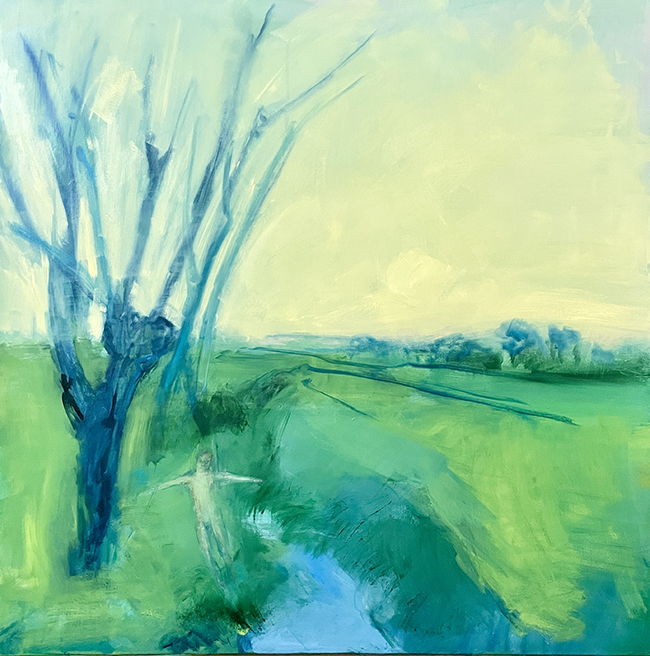
Another work dives below the surface. This one reads like a pond seen from above, its depths stirred by wind or life beneath. The palette shifts: deep greens, aquas, and hints of yellow swirl in layered transparencies. Lemay gives no clear outlines of lily pads or fish—just impressions. Shapes emerge and submerge. A streak of yellow might be light, or a blade of grass, or a ripple. That’s the thing about Lemay’s abstraction—it holds the trace of things, but never locks them in. Her compositions aren’t puzzles to solve; they’re invitations to linger.
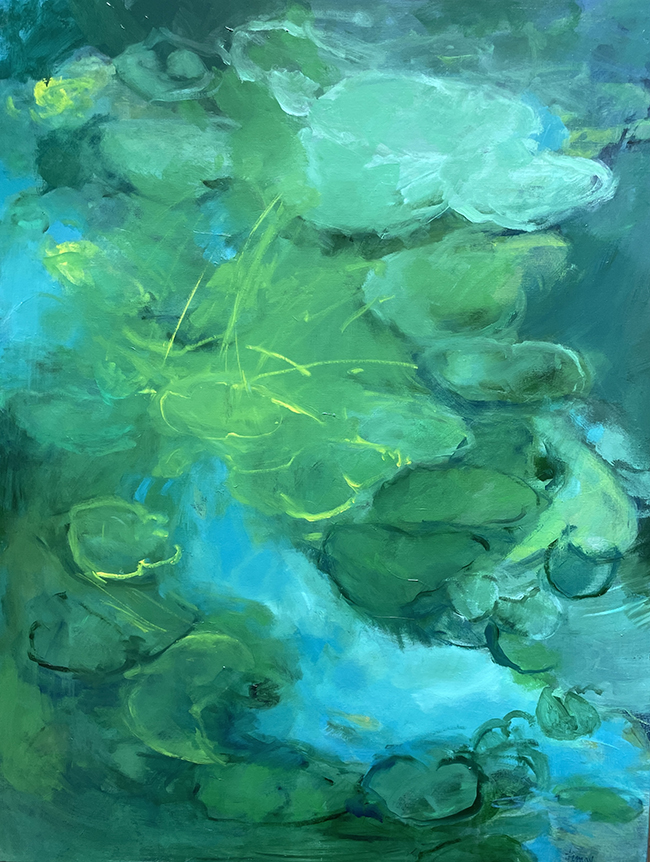
A third canvas moves inland—toward fields and trees. A tall bare tree stands at the left, rooted in a grassy verge. Behind it, green fields roll away in layers of blue and chartreuse. At the edge of a narrow stream, a human figure appears. The body is barely sketched—transparent, dreamlike—but it stands with arms open, as if in greeting, or surrender. The landscape here isn’t dramatic. It’s quiet. But it holds a tension—a pull between solitude and connection. Lemay’s use of scale and openness creates space for reflection. There’s always a sense of room in her work. Room to enter. Room to feel.
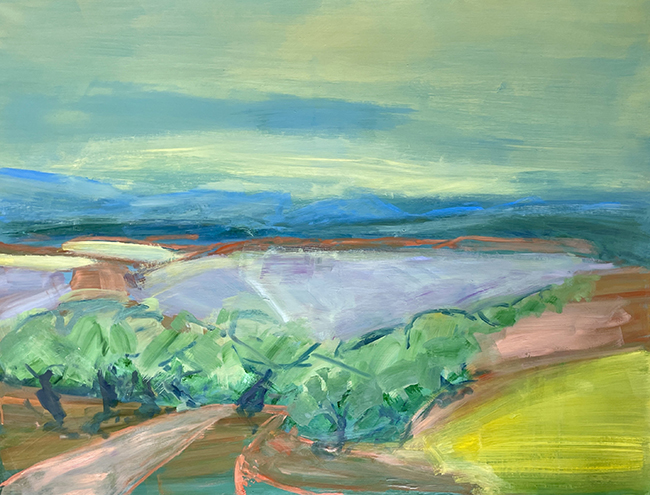
Across all her paintings, Lemay returns to certain themes: the trace, the threshold, the tension between permanence and disappearance. Trees, rivers, cliffs, skies—these are not just scenery, but recurring presences in her work. They are familiar but never fixed. Instead, they shift with each canvas, becoming more or less abstract, depending on what the painting seems to ask for.
There is an ecological undercurrent in Lemay’s art, but it’s not didactic. She doesn’t paint to make statements. She paints to rekindle intimacy with the land, with light, with natural cycles that are easy to overlook. “To paint,” she writes, “is to pay attention. To slow down.” That ethic of attention comes through in the way her brush holds the edge of a shadow or the blur of a shoreline. These are not hurried works. They are quiet, deliberate acts of care.
What stands out is her refusal to separate the emotional from the environmental. Her paintings are rooted in place, but also in feeling. They carry a sense of mourning for what’s vanishing—coasts, trees, ecosystems—but also a deep gratitude for what still remains. Her art doesn’t shout. It listens. It leans in.
Eva Lemay’s landscapes remind us that the world doesn’t need to be spectacular to be worthy of reverence. A pond, a tree, a patch of light on the water—these can be enough. Through her painting, she asks us to see again. And not just to see, but to feel.

